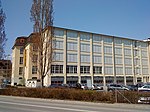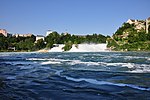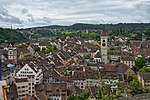Cholfirst Radio Tower
1973 establishments in Switzerland20th-century architecture in SwitzerlandBuildings and structures in the canton of ZürichCanton of Zürich geography stubsSwiss building and structure stubs ... and 2 more
Towers completed in 1973Towers in Switzerland

Cholfirst Radio Tower is a 96-metre-tall (315 ft) lattice tower on Cholfirst Mountain at Flurlingen, Canton of Zurich, Switzerland. The tower was built in 1973 by PTT on Cholfirst Mountain, a 570-metre (1,870 ft) mountain near Flurlingen (47°40′51″N 8°38′48″E) after 3 years of successful operation of an experimental TV transmitter on channel 47 on a 40-metre-tall (130 ft) tower nearby. The construction of Cholfirst Radio Tower cost 7 million Swiss Francs. On request of Flurlingen community it was equipped with an observation deck, accessible for tourists by stairway (no elevator) in a height of 42 metres, of which additional costs were paid by PTT.
Excerpt from the Wikipedia article Cholfirst Radio Tower (License: CC BY-SA 3.0, Authors, Images).Cholfirst Radio Tower
Lachenstrasse,
Geographical coordinates (GPS) Address Nearby Places Show on map
Geographical coordinates (GPS)
| Latitude | Longitude |
|---|---|
| N 47.680833333333 ° | E 8.6466666666667 ° |
Address
Lachenstrasse
Lachenstrasse
8247
Zurich, Switzerland
Open on Google Maps










